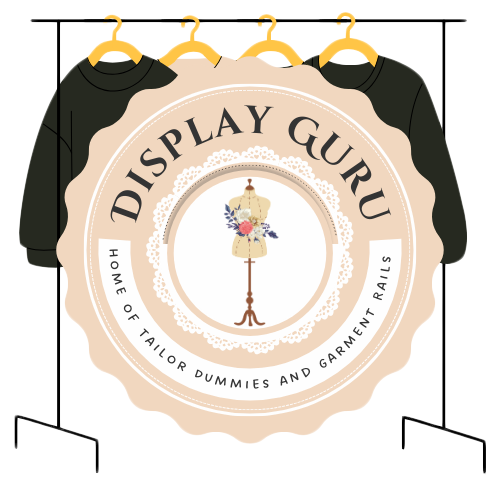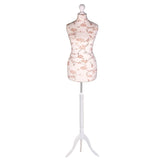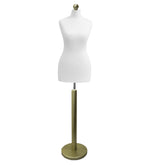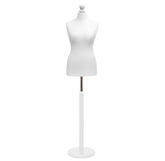Tailor Dummy Male Guide: Transform Your Fitting Game
Your Silent Partner: Understanding the Tailor Dummy Male
Every tailor's workshop has an unsung hero. It's the one collaborator who stands perfectly still for hours, never flinches at being poked with pins, and offers a consistent, reliable shape for your work. We're talking about the tailor dummy male, your most dependable colleague.
This tool is much more than a simple stand for showing off finished clothes. It is the very foundation on which professional bespoke work and high-quality alterations are built. For many tailors, the difference between an amateur finish and a masterful creation is defined by the expert use of this three-dimensional form.
A quality male dummy is where a flat, two-dimensional pattern comes to life. It allows you to see precisely how fabric will drape and fold around the male physique, taking the guesswork out of the fitting process. This is where you can perfect the architecture of menswear long before a client ever tries it on.
The Anatomy of Precision
So, what separates a male dummy from its female counterpart? The distinction is in the subtle but critical anatomical proportions. While a female form focuses on the curves of the bust, waist, and hips, a tailor dummy male is built around the width of the shoulders, the shape of the chest, and the straighter line from the waist to the hips.
These details are paramount for getting the fit of jackets and shirts just right. The clean hang of a suit jacket, the proper break of a pair of trousers, and the smooth fit across the upper back are all dictated by these distinctly male proportions.
Without a form that accurately reflects this structure, achieving a sharp, structured silhouette is nearly impossible. The dummy serves as a constant, unwavering reference point, helping you assess balance, symmetry, and drape with an objective eye. This is especially vital when setting in sleeves or shaping lapels—tasks that demand absolute stability.
From Bespoke Heritage to the Modern Workshop
The use of these forms is a practice with deep historical roots. The history of the tailor's dummy in the UK is closely tied to the rise of bespoke tailoring and ready-to-wear clothing from the 19th century onward. Before the Industrial Revolution, tailors relied on these figures—often headless and made from wood or wicker—to meticulously fit and adjust men's suits. You can discover more about their evolution here.
This historical image showcases early forms that, while basic, served this fundamental purpose.
Even in these rudimentary designs, the emphasis on the torso and shoulder structure is clear. It shows that from the very beginning, artisans understood the need for a stable, representative human shape to build their creations upon. Today’s models are simply a more refined and accurate evolution of this timeless principle.
By understanding its role not just as a tool but as a precision instrument, you transform it from a static object into an active participant in your creative process. It becomes your standard, ensuring that every piece you craft meets the highest benchmarks of quality and fit, truly separating the dedicated hobbyist from the professional artisan.
Finding Your Perfect Match: Tailor Dummy Male Types
Choosing a tailor dummy male is a lot like a photographer selecting a lens; the one you pick fundamentally shapes the outcome of your work. Not all forms are built the same, and knowing the distinct types is the first step toward a smart investment for your craft. Your final choice will hinge on your primary tasks, whether you're creating custom suits, managing a busy alterations shop, or designing an entire collection.
The Classic Fixed Form Dummy
The most traditional option you'll encounter is the fixed form or display dummy. Think of this as the reliable workhorse of the studio. It's a solid torso, usually made from fibreglass or dense polystyrene, and is built to a specific UK standard size (for example, a 40" chest). Its biggest asset is its absolute consistency.
Because it isn't adjustable, it provides a perfectly stable and anatomically correct foundation for draping fabric and building a garment's structure from the ground up. For bespoke creators who draft patterns for a single, specific size, this type is essential. It delivers a true silhouette without the small bumps or gaps that can appear on adjustable models. You can explore a great example of a classic male torso dummy with a sturdy tripod stand here to see these features up close.
The Versatile Adjustable Dummy
For professionals who work with a variety of client sizes, the adjustable dummy is a true problem-solver. These forms have a series of dials—typically between 8 to 12 of them—that let you expand or contract the chest, waist, and hip measurements within a given range. This adaptability makes them perfect for alteration services, where you might need to replicate a 38" waist one day and a 42" the next.
However, this flexibility does come with a trade-off. When expanded to its maximum settings, small gaps can form between the panels, which can sometimes snag a pin or disrupt a smooth drape. They are a brilliant tool for checking the fit of finished garments but can be less suited for foundational draping than a solid fixed form.
Specialised and Full-Body Forms
Beyond the standard torso, you can find more specialised models to fit specific needs. Full-body forms that include legs are indispensable for anyone who regularly makes trousers, as they allow you to accurately check the inseam, rise, and overall drape of the garment. Another point to consider is the choice between a headed or headless dummy. While headless models make dressing and undressing the form much easier, a headed dummy is useful for seeing how a collar or neckline will frame the face.
The longevity and performance of these forms often come down to their internal construction and the quality of the materials used.
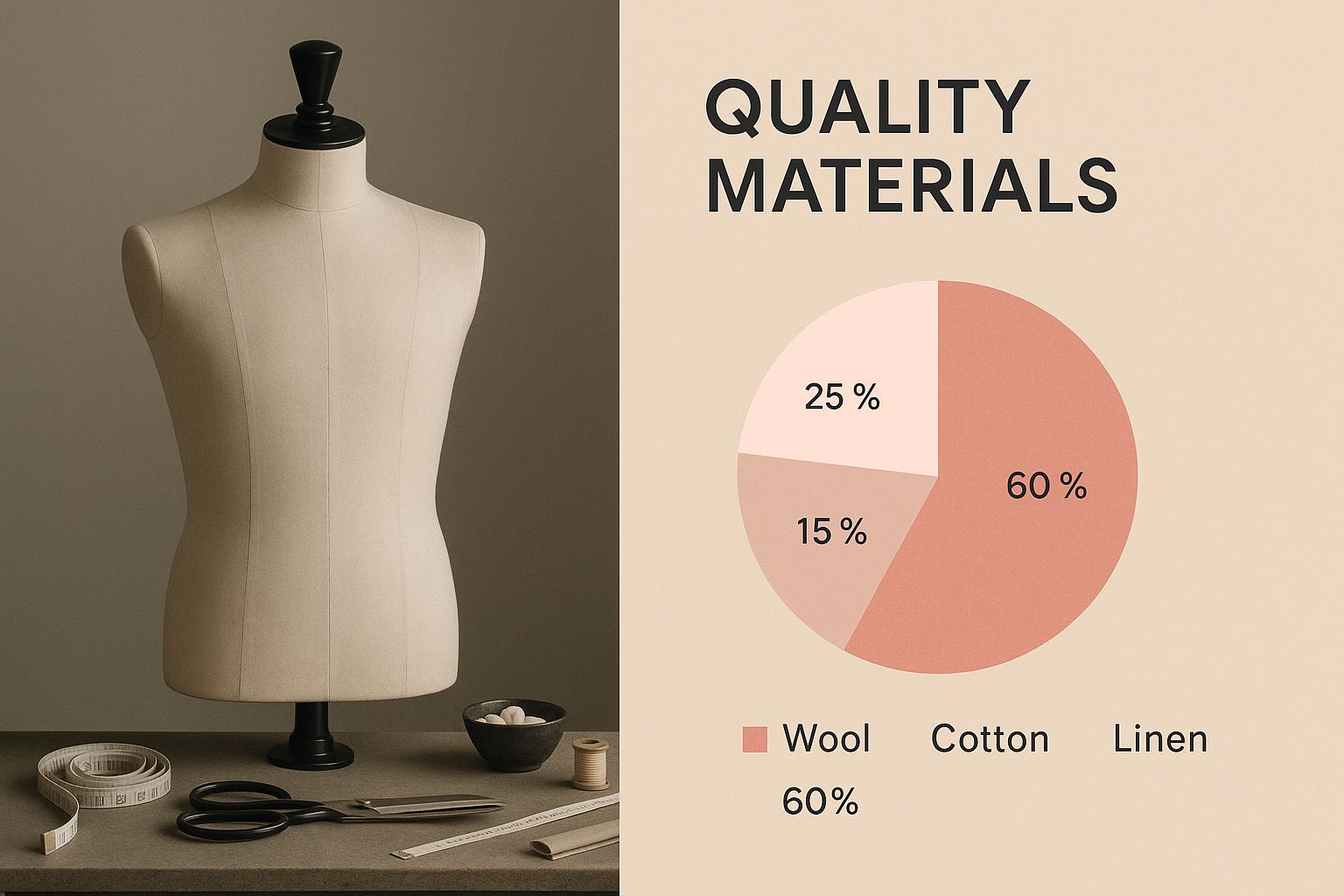
This image highlights that a durable core and a high-quality fabric cover are critical for a professional tool that needs to endure constant pinning and daily use.
To help simplify your decision, here is a comparison of different male tailor dummy types, their features, best uses, and price ranges.
Male Tailor Dummy Types Comparison
| Dummy Type | Key Features | Best For | Price Range | Pros | Cons |
|---|---|---|---|---|---|
| Fixed Form | Solid body, standard sizing, pinnable surface. | Bespoke garment creation, draping, pattern making. | £ | Extremely stable, true to a standard size, gives a professional finish. | Limited to one size, not practical for fitting multiple clients. |
| Adjustable | Dials to change chest, waist, and hip sizes. | Alterations, fitting for multiple clients, fashion students. | ££ | Highly adaptable for various sizes, cost-effective for varied work. | Less stable than a fixed form, gaps can appear, less "natural" shape. |
| Full-Body | Includes legs and sometimes arms or a head. | Trouser fitting, full suit work, costume design. | £££ | Allows for fitting a complete outfit accurately from head to toe. | More expensive, bulkier, harder to store and dress. |
As the table shows, the ideal choice often comes down to a trade-off. You must weigh the unwavering stability of a fixed form against the practical flexibility that an adjustable model provides for working with different body shapes and sizes.
Built to Last: Materials That Make the Difference
The materials used to construct a tailor dummy male are what truly determine its quality and lifespan. This is what separates a dependable workshop tool from a source of daily frustration. Much like a chef's knife, where the quality of steel defines its performance, a dummy's core construction and its fabric cover dictate how well it functions and holds up over time.
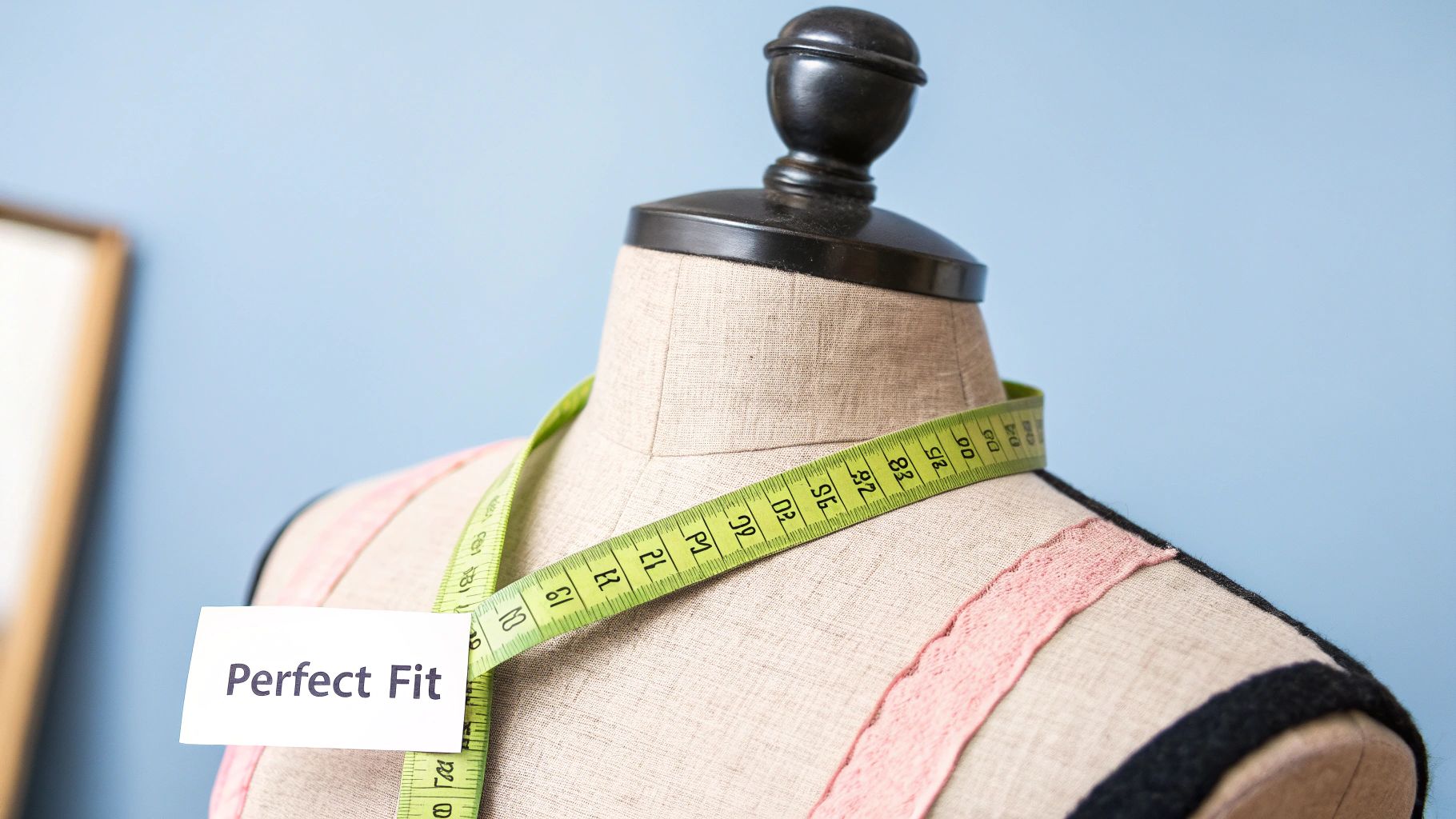
The Inner Strength: Core Materials
The core is the dummy's foundation, providing the essential shape and strength needed to withstand fittings and adjustments. In the past, you might have seen forms made of papier-mâché. Although lightweight, this material has a critical flaw: it absorbs moisture and can easily warp from the steam of an iron, making it unsuitable for a busy workroom.
Modern professional forms are built with one of two far superior materials:
- Fibreglass: This option produces an exceptionally hard and rigid body that maintains its exact shape for decades. It stands up to heat and steam without any problems. The one limitation is that a pure fibreglass form is not pinnable, so it acts as a solid base for fitting rather than for draping.
- High-Density Polystyrene/Foam: This is the material of choice for most working tailors today. The dense foam is firm enough to create a realistic torso shape but soft enough to allow for full pinnability. This means you can stick pins directly into the form at any angle, which is absolutely vital for draping fabric and securing pattern pieces.
The Working Surface: Fabric Coverings
If the core is the foundation, the fabric covering is the working surface. This outer layer directly affects how fabric drapes and the ease with which you can work. A cheap, slippery cover will cause constant headaches, while a quality one becomes an asset.
A very common and effective choice is a tightly woven jersey fabric cover. It finds the perfect balance—smooth enough not to snag delicate materials but with enough texture to stop fabrics like silk from sliding off. This practical approach is seen on many standard models, like a classic black torso bust with a sturdy stand.
Another great option is traditional linen or canvas. These materials offer a superior grip, making them ideal when working with heavy fabrics like tweed or denim that need to be held securely. The best choice often comes down to the types of garments you make most often.
Regardless of the fabric, the covering must be applied tautly, with no wrinkles or sagging. A well-constructed covering is a key indicator of a professional-grade tool.
Precision Engineering: Mastering Adjustable Features
While a solid core and a quality cover provide the skeleton of a good mannequin, it’s the adjustable features that give a tailor dummy male its soul. These mechanisms transform the dummy from a static statue into a dynamic tool for fitting. They allow you to take a client's measurements off the page and build them into a physical, three-dimensional form you can work with. Learning to use these features is what separates a good fit from a perfect one.
The Core Mechanisms: How Adjustments Work
At the center of any adjustable dummy is a system of dials or keys, usually numbering between 8 and 12 on a typical model. Think of them like the adjustment levers on an office chair; each one controls a specific area, but together they create a completely personalized fit. When you turn a dial, an internal mechanism gently pushes segmented body panels outward or pulls them inward.
This clever design allows for incredibly precise changes. The secret is to make small, balanced adjustments across the entire dummy instead of maxing out one area. This method ensures the form keeps a natural, human-like shape and avoids creating odd gaps or strange proportions. It’s a process that calls for a bit of patience, but the payoff is a form that truly reflects your client's body.
Key Adjustments for Menswear Tailoring
For menswear, some adjustments are more important than others, especially when working on structured clothing like suit jackets and vests. Nailing these on the dummy first can save you a huge amount of time and effort during fittings with a real person.
- Chest and Waist Expansion: This is your most-used feature. It lets you perfectly match the client’s chest and waist size, which is essential for making sure a jacket doesn't pull at the buttons or that a waistcoat sits smoothly against the torso.
- Shoulder Width and Slope: A man's shoulders define the entire silhouette of a suit. Adjustable shoulders help you match the dummy to clients with either broad or narrow frames. Some advanced models even offer shoulder slope adjustment, a critical feature for getting a jacket collar to sit cleanly on the neck without any awkward gaping.
- Neck and Back Length: Fine-tuning the neck size is key to perfecting the fit of a shirt collar. The ability to change the back length is also vital for getting the overall balance and drape of a jacket just right.
While adjustable dummies provide fantastic flexibility, they are often designed to work within standard sizing conventions. Understanding these base measurements helps you know your starting point before you begin making finer adjustments.
Standard Male Sizing Measurements for Tailor Dummies
Key measurements and size ranges for male tailor dummies across different UK clothing sizes
| Size | Chest (inches) | Waist (inches) | Shoulder Width | Neck | Hip |
|---|---|---|---|---|---|
| Small (36-38) | 37" - 39" | 31" - 33" | 17.5" - 18" | 15" - 15.5" | 37" - 39" |
| Medium (40-42) | 40" - 42" | 34" - 36" | 18.5" - 19" | 16" - 16.5" | 40" - 42" |
| Large (44-46) | 43" - 45" | 37" - 40" | 19.5" - 20" | 17" - 17.5" | 43" - 45" |
| X-Large (48-50) | 46" - 49" | 41" - 44" | 20.5" - 21" | 18" - 18.5" | 46" - 49" |
As the table shows, an adjustable dummy needs to cover a wide spectrum of sizes. Your goal is to use the adjustment dials to move from these standard blocks to the unique measurements of your individual client.
Common Pitfalls and Proper Maintenance
The most frequent mistake people make is over-extending the dummy. Pushing the dials to their absolute limits can put stress on the internal parts and create wide gaps between the panels. These gaps can snag delicate fabrics or cause pins to slide right through. Always work within the dummy’s specified range and expand all sections evenly to keep the surface smooth. You can get a closer look at the Display Guru adjustable dummy to see how these professional systems are built.
Looking after your dummy is simple. Every so often, turn each dial through its complete range of motion to keep the mechanisms from getting stiff. A quick vacuum or dusting of the interior, if you can access it, will stop dust from jamming the moving parts. If you treat your adjustable tailor dummy male like the piece of precision equipment it is, it will be a reliable partner in your work for many years.
Rock-Solid Foundations: Stands That Support Success
Working with a wobbly tailor dummy male can make even simple tasks feel impossible. It’s like trying to sketch a perfect portrait on a table that shakes with every stroke—no matter how steady your hand, the unstable surface ruins your work. The stand is much more than a simple pole; it's the foundation that supports every stitch, pin, and drape.

The way a stand is constructed has a direct effect on your entire process. From heavy cast-iron bases that offer maximum stability to lighter, more mobile options, choosing the right stand is a key decision that will affect your work every day.
Choosing Your Base: Tripod vs. Pedestal
You'll generally find two main styles of bases for tailor dummies: the tripod and the pedestal. Each one comes with its own set of practical advantages.
A pedestal base is usually a single, heavy, flat disc, often made of cast iron. Its main strength is its incredible stability combined with a small footprint. The dense weight anchors the dummy firmly to the floor, which is a huge benefit when you’re working with heavy garments like wool coats. This makes it an excellent option for smaller workrooms where floor space is a premium.
On the other hand, the tripod stand provides a more traditional look and spreads the dummy's weight across three legs. Though it takes up more space, many professionals find this style to be incredibly steady, particularly on floors that aren't perfectly level. A wooden build, like the one on this dummy with a red wood tripod stand, can also add a classic feel to your space. Some tripods even feature wheels, giving you both stability and easy movement around the workshop.
Practicality in the Workshop
Beyond the base, a few other features are critical for everyday use. A dependable height adjustment mechanism is absolutely essential. You’ll want a simple, strong system that locks in place without any risk of slipping, even with the weight of a heavy jacket on it. This lets you set the garment at a comfortable height, whether you're sitting to pin a hem or standing to perfect the shoulders.
Proper weight distribution is what saves you from that gut-wrenching moment when a form starts to tip over. A well-made stand keeps the center of gravity low and secure, even if a garment's weight isn't perfectly balanced. A little bit of routine care will ensure this stability lasts for years.
- Check the fittings: Periodically make sure all screws and bolts on the stand are tight.
- Keep it clean: Wipe down the pole and base to remove dust, which can interfere with adjustment parts.
- Inspect the castors: If your stand has wheels, clear away any stray threads or debris so they continue to roll smoothly.
Making the Smart Choice: Your Tailor Dummy Male Selection
Choosing the right tailor dummy male goes beyond a simple feature comparison. Think of it less like buying equipment and more like investing in a silent partner who will directly influence the quality and fit of every garment you create. A thoughtful choice from the start saves you from the frustration and cost of a form that complicates your work instead of supporting it.
To make the right call, start with an honest look at what you do every day and what your craft truly requires from a form.
Assess Your Primary Craft
The ideal dummy for a tailor focused on bespoke suits is fundamentally different from one used in a high-volume alterations shop. Let your daily workflow be your guide.
-
For Bespoke Tailoring: When your main job is to draft patterns and construct clothing from bolts of fabric, a fixed form dummy is often the best choice. Its solid, anatomically precise shape provides a consistent and stable foundation, which is perfect for draping fabric and ensuring the garment’s structure is sound before you even make a single stitch.
-
For Alterations: If you're constantly working with a diverse clientele, an adjustable dummy becomes your most essential assistant. The power to dial in specific chest, waist, and hip measurements lets you closely replicate a client's body shape, which can save a tremendous amount of time in fittings.
-
For Education and Display: When your goal is to teach the art of tailoring or to display finished pieces in a retail setting, you need a mix of durability and visual appeal. A robust model featuring a classic wooden stand typically provides the right combination of professional utility and aesthetic charm.
Evaluating Your Workspace and Sizing Needs
Beyond the craft itself, the physical constraints of your workshop are a major factor. A full-body form with arms and legs is fantastic for trouser and jacket work, but it might be completely impractical in a compact home studio. Be sure to measure your available area and think about the dummy's entire footprint, including its stand. For example, a pedestal base generally occupies less floor space than a tripod.
Equally critical is a commitment to UK-specific sizing standards. Using a dummy built to these measurements ensures that your finished garments are directly relevant to your local customers. This principle isn't new; historical records show that in late 19th-century London, there was about one tailor for every 56 inhabitants. This massive workforce relied on forms that matched the physique of the local population to work efficiently. You can read more about this historic tailoring army and their methods.
Beyond the Price Tag: Long-Term Value
Finally, resist the temptation to let the initial price be your only guide. A cheap dummy that breaks or becomes unstable within a year is no bargain at all. Look into the supplier's reputation, the warranty they offer, and whether they provide support after your purchase. A dependable supplier offers peace of mind and help if any mechanisms or parts need attention down the line.
A model like the Display Guru male torso with a silver wood tripod stand is a perfect example of a solid option that comes with dedicated support. See this decision not just as a purchase, but as bringing on a silent apprentice who will support your work reliably for many years.
Maximizing Your Investment: Care and Advanced Techniques
A tailor dummy male is much more than just a piece of equipment; it's a long-term investment in your work. To truly get the most out of it, you need to combine proper care with smart techniques. Good maintenance ensures it lasts for years, while advanced skills can turn it from a simple form into an active partner for creating perfectly fitted garments.
The Foundations of Longevity: Proper Care and Maintenance
Just like any professional tool, your dummy needs consistent upkeep to perform its best. For routine cleaning of a jersey or linen cover, a simple lint roller is perfect for removing dust and loose threads. If you spot a small mark, gently dab it with a damp cloth and a bit of mild soap, but always test on an inconspicuous spot first. It's best to avoid harsh chemical cleaners, which can damage the fabric and the foam underneath.
The surface of your dummy is your canvas, so keeping it in top condition is key. Always opt for sharp, high-quality pins. Dull pins can snag the cover and leave permanent, large holes in the foam core. For marking, stick to professional tailor's chalk that can be brushed away easily. Using ink or permanent markers is a recipe for disaster, as they can stain the dummy and transfer onto your project's fabric.
How you store your dummy between projects makes a big difference. A dust cover is a simple way to keep it clean, prevent the fabric from fading, and protect it from accidental scuffs. Find a spot in a dry room away from direct sunlight, as UV rays can make the cover material brittle over time.
If you have an adjustable tailor dummy male, don't forget about its internal parts. Every so often, turn each dial through its full range of motion to keep the mechanisms from seizing up. If a dial feels stiff, inspect it for trapped threads or debris before you try to force it. It's also important to know when a dummy has reached the end of its life. While you can patch minor tears, significant issues like crumbling foam or a broken adjustment dial mean it’s time for a replacement.
Beyond the Basics: Advanced Fitting and Creative Applications
Once you've mastered maintenance, you can move on to the real art of using your dummy: shaping it to match a specific person. A great fit is about more than just measurements; it’s about posture and proportion. By strategically adding layers of foam or batting, you can replicate unique body shapes, like a rounded back, a broad chest, or sloped shoulders. This effectively turns your generic dummy into a custom body double for any client.
This technique opens the door to several advanced applications that go far beyond simple draping:
- Recreating Real Posture: Use wadding to copy a client’s natural stance, whether they have stooped shoulders or a forward neck, to see exactly how a garment will hang on them.
- Fitting for Asymmetry: No body is perfectly symmetrical. Padding one side of the chest or hips allows you to create a truly custom fit that accounts for these natural differences.
- Developing Patterns in 3D: You can drape fabric directly onto the padded form, allowing you to design and perfect the garment in three dimensions right from the start.
- Presenting Your Craftsmanship: A tailor dummy male serves as an ideal model to showcase your finished pieces, giving them a professional shape that highlights your skill without needing a live model.
Your dummy can also be an excellent communication tool. During client fittings, you can use it to show exactly where you plan to make an alteration or explain why a certain cut will flatter their shape. This visual aid helps clients understand your process, builds their trust, and underscores your professional expertise.
A well-cared-for dummy that you know how to use becomes an indispensable assistant in your work. It's a silent partner that helps you achieve the perfect fit and present your creations beautifully. To find the right foundation for your craft, you can explore a full range of high-quality dummies and stands at Display Guru, where you can find reliable tools to support your best work.
Article created using Outrank
